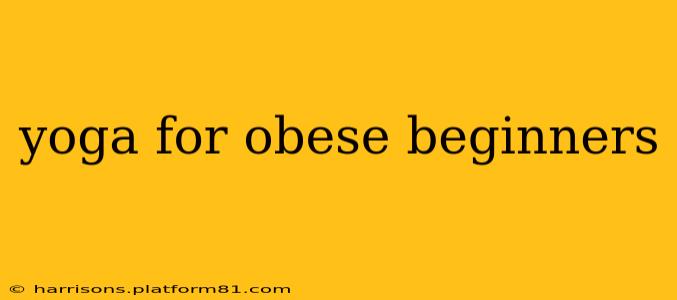Yoga, often perceived as an activity for the already flexible and slender, is actually a remarkably accessible practice for people of all body types, including obese beginners. This misconception stems from a lack of understanding of the adaptable nature of yoga and the multitude of modifications available. This guide will explore how yoga can benefit obese individuals and offer a safe and effective starting point. It's crucial to remember that consistency and listening to your body are key to a successful yoga journey.
Is Yoga Safe for Obese Beginners?
Yes, yoga is generally safe for obese beginners, provided it's practiced correctly and with proper modifications. The key is to start slowly, focus on breathwork, and choose a style that accommodates your current fitness level. Avoid overly strenuous poses and prioritize comfort over pushing your limits. Many poses can be modified to suit different body weights and flexibilities. A qualified instructor can guide you through safe modifications.
What are the Benefits of Yoga for Obese People?
Yoga offers a multitude of benefits for obese individuals, addressing both physical and mental well-being:
- Improved Flexibility and Mobility: Yoga gently stretches tight muscles, improving range of motion and reducing stiffness often associated with carrying excess weight.
- Increased Strength and Balance: Certain yoga poses build strength, particularly in the core, legs, and back, improving stability and reducing the risk of falls.
- Weight Management: While not a direct weight loss solution, yoga can support weight management by increasing metabolism and promoting mindful eating habits.
- Reduced Stress and Anxiety: Yoga’s emphasis on mindful breathing and meditation helps reduce stress hormones, promoting relaxation and improving mental well-being.
- Improved Cardiovascular Health: Certain yoga styles can improve cardiovascular health by increasing heart rate and blood flow.
- Increased Self-Esteem: As you gain strength and flexibility, you'll likely experience an increased sense of accomplishment and self-esteem.
What Type of Yoga is Best for Obese Beginners?
For obese beginners, gentler styles are recommended:
- Hatha Yoga: This foundational style focuses on basic postures and breathwork, making it ideal for beginners.
- Restorative Yoga: This slow-paced style utilizes props like blankets and bolsters to support the body, making poses accessible and relaxing.
- Yin Yoga: This passive style emphasizes holding poses for extended periods, improving flexibility and promoting relaxation.
Avoid styles like Ashtanga or Vinyasa, which are more vigorous and demanding. Always prioritize a style and pace that allows you to focus on proper form and breath rather than pushing yourself beyond your limits.
What are Some Modifications for Obese Beginners?
Many yoga poses can be modified to accommodate different body sizes. Common modifications include:
- Using props: Blankets, blocks, and bolsters can provide extra support and stability, making poses more accessible.
- Modifying poses: Instead of striving for the perfect alignment, focus on comfortable variations.
- Sitting on a chair: Some poses can be performed while seated on a chair, eliminating the need for floor-based movements.
- Listening to your body: Pay attention to your body's signals and rest when needed.
How Can I Find a Suitable Yoga Class?
When searching for a suitable yoga class, look for:
- Beginners' classes: These classes focus on fundamental poses and breathing techniques.
- Experienced instructors: A qualified instructor will provide modifications and adjustments to ensure your safety and comfort.
- Classes emphasizing body positivity: A supportive and inclusive environment can make a significant difference in your experience.
Remember that starting a new exercise routine involves some risks. Consult your physician before starting any exercise program, especially if you have any underlying health conditions.
How Often Should I Practice Yoga?
Start with 2-3 sessions per week, gradually increasing the frequency as your strength and flexibility improve. Consistency is more important than intensity. It's better to have shorter, regular sessions than infrequent, long ones.
Can I Do Yoga at Home?
Yes, many online resources provide yoga classes suitable for beginners. However, it's advisable to participate in a few in-person classes initially to learn proper technique and body alignment from a qualified instructor before practicing independently at home.
Yoga for obese beginners isn't just about physical fitness; it’s a journey towards self-acceptance, self-compassion, and overall well-being. By embracing a slow, mindful approach and focusing on what your body can do rather than what it can't, you can unlock the transformative power of yoga. Remember to be patient with yourself and celebrate every small victory along the way.
